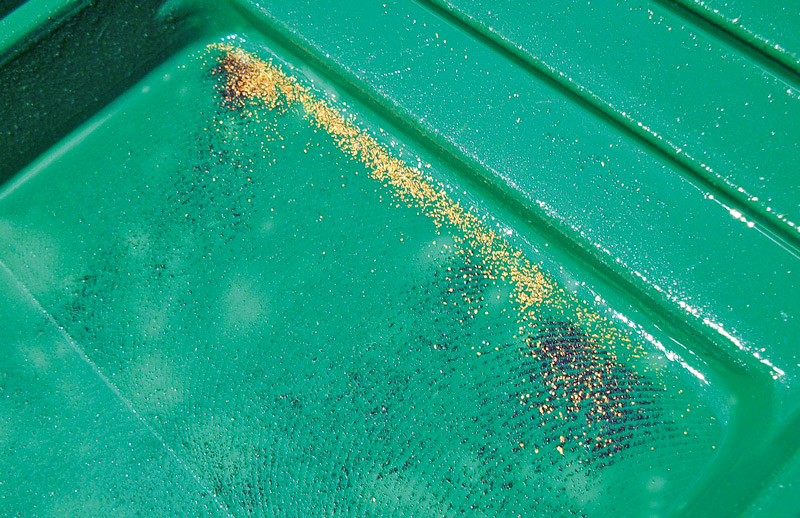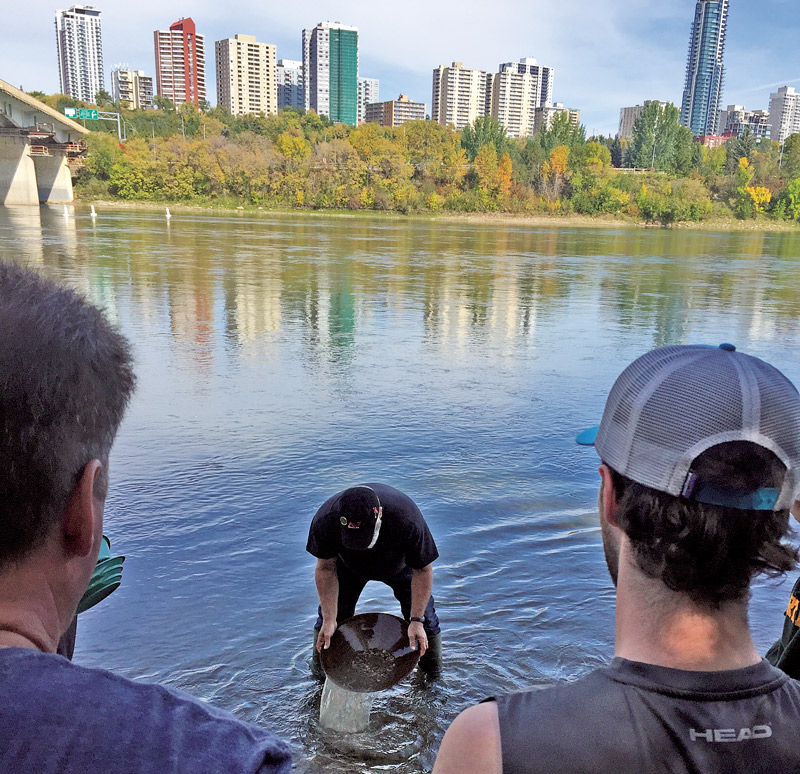Gold Fever Dreams

Gold Fever Dreams: Gold Panning in Alberta
by Sylvia Dekker
They call it gold fever because it’s a bit of an illness,” panner David Elder says.
Whether the antidote, a symptom, or aggravator, panning for gold is an excellent excuse to get outside and chill out by the river.
“Panning is an addictive, fun, relaxing activity, but far from a get rich quick scheme,” says Melissa Bowerman, geologist and assistant curator at the Royal Alberta Museum. Her comment accurately sums up the sentiment of many Albertan gold panners.
Because while there is still plenty of gold to be found in our waterways, most of it is the finest of placer golds known as flour gold: miniscule bits of the precious metal less than a tenth of a millimetre in diameter.
It can take a while to accumulate anything measurable, but it’s the thrill of discovery, the ancient fascination with treasure, and spending time in nature that fuel people like Elder to “drive a few hours, camp near the river, spend six hours or more a day digging, putting gravel and dirt in a pan.”

Gold can still be found in Alberta waterways and if you get lucky, a pan like this is possible.
Alberta’s history is flecked with gold hunting. The first reports of gold panned out of the North Saskatchewan River 165 years ago sparked a zeal for shiny particles across the province.
“By the turn of the century, Edmonton saw gold dredges working the gravel of the North Saskatchewan River, with a dozen dredges peaking production between 1895 and 1897,” says Bowerman.
The Klondike Gold Rush attracted most miners away from the Edmonton area after that, but spikes in gold prices, The Great Depression, and several significant wars reignited brief surges in gold production.
Present day gold extraction in Alberta is done by sand and gravel pit operations as a sort of glittery side hustle, and by individual placer miners and panners as a fresh air saturated past time.
Back in the gold rush days, panning was a way to read the creek, and looking for clues on where the motherlode might be.
Prospector and writer Mitch Binichakis says flour gold is evidence of being a long way from the source. Pulling out flakes and then chunks can mean you’re getting warmer, especially if the pieces have jagged edges.
Bowerman agrees, explaining that bouncing over the river bed for long distances mills larger chunks of the malleable metal into the fine, smooth particles we can pan out of the Red Deer, North Saskatchewan, McLeod, Athabasca, Peace and Crowsnest rivers. In Alberta’s case, the motherlode that ignites every prospector’s dream is safely stowed in the protected bedrock of Jasper National Park.

Gold panning on the North Saskatchewan River in Edmonton.
The density of this precious metal—being six times heavier than the typical stream’s sand, silt and rocks—is what makes panning possible. Plus, it determines when and where to pan.
“Pick a spot where the water is slowest,” says Bowerman, such as on the inside of bends, in meandering sections, and pool bottoms. “Slow water allows heavy stuff to drop out.”
Panning is best done mid-August onward, Bowerman says, since low water levels expose sandy banks that make rich, ideal places to pan. Low-water periods following floods and the spring thaw tend to result in especially sparkly pans as well.
Given it’s cheap to try out and even the tiniest gold discovery universally leaves humans starry eyed, panning is a very popular hobby. All you need, says Elder, is “a shovel, a classifier or sieve to get rid of any rocks, a gold pan, and a snuffer bottle” to suck up any gold you might find. Kits or individual items can be purchased at a variety of outdoor and prospecting shops or online.
Spot and supplies acquired, panning is a series of shoveling, sloshing, swirling, squinting and, hopefully, snuffing. Water is your friend.

Snuffer bottles are used to suck fine gold out of your pan.

ROYALTY PAYMENT
Royalty payments depend on the amount of gold recovered during the licence year (one year from the licence date). If 1 troy ounce (31.1g) or less is recovered, no royalty is due. If more than one troy ounce is recovered, a royalty of 5% must be paid. The royalty payments ensure that people of Alberta—the resource owners—receive a fair return on their resources.
– Government of Alberta
Shovel gravel and sand into your pan, sieving or handpicking large rocks and pieces out. Pointing your pan so any heavy stuff will get caught in the riffles, submerge your pan in the stream and slosh larger and lighter material out of your pan using a combination of side to side and back and forth flipping motions.
Eventually, when the water runs clear, you’ll be left with black sand: concentrated heavy minerals of sediments. Swirl your pan to spread out the sand, illuminating any thrilling glimmers of gold. Suppress your excitement long enough to suck any of the shimmering light yellow to coppery, rusty coloured bits out with your snuffer bottle.
If you’re out there shoveling sand in a pan anyways, keep an eye out for other shiny things; Bowerman says platinum and diamonds can also be found on the edges of Alberta river systems.
It can take some demonstration and practice to get the feel for effective panning, but there are plenty of opportunities to learn from experts. The Alberta Gold Prospectors Association (AGPA) and the Edmonton Geological Society hold learning events in Devon or Emily Murphy Park in Edmonton where, Bowerman says, “There is always gold.”
AGPA likes to say, “Gold is where you find it,” and if you do find gold you don’t need to pay royalties (to Albertans as resource owners) until you’ve recovered over one troy ounce (31.1 grams) in one year. This is highly unlikely while getting lost in the repetitive swirl and river’s chorus, though. Until the fever has influenced you to the point of placer mining with a sluice box, you won’t need to get a licence to do a little shoveling on the river bank either.
Both Bowerman and Binichakis tell me gold panning has minimal impact on stream ecology and since one person can only shovel so much sand and gravel in one day, the effects on the streambed are negligible. Once the operation scales up into placer mining territory, the potential for damaging fish habitats increases, thus regulations are in place for sluices and other equipment beyond a shovel and pan.
Fanning the fever can lead to discoveries of a large community and unique culture besides treasure. Folks with the spark for gold are passionate, excited, and keen to get others sucked into the hobby. AGPA hosts events throughout the year including a campout and dinner, and this year the World Gold Panning Championships will be held in the Czech Republic.
If the thought of spending time soaking in fresh air, listening to the stream ripple by and maybe—just maybe—finding shimmery treasure sounds inviting to you, grab a pan, find someone already infected with the fever to show you the ropes, and hit the river.



